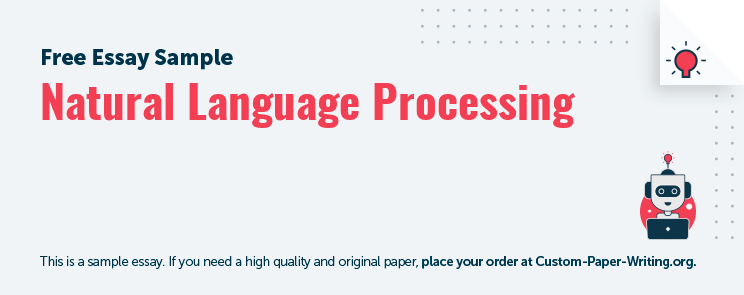
Introduction
Natural Language Processing (NLP) is a large and multidisciplinary field that entails artificial intelligence, computational linguistics, and computer science. It relates to communications between natural or human languages, and computers. As such, it involves both the usage and the ability of synthetic intelligence systems to transform specialized artificial computer information to natural languages that are practical and understandable to people. Therefore, NLP creates an efficient human-computer interaction (HCI) that examines the use and design of computer technology. In doing that, it focuses on interfaces between users and computers. Such connection has led to the development of the necessary tools and techniques, enabling manipulation of natural languages by use of computer systems to achieve desired tasks. Therefore, with these abilities it has become widely acceptable that NLP plays a vital role in helping medical organizations and professionals to accomplish their goals.
Calculate the cost of essay
Benefits of NLP in the Field of Healthcare
NLP has several advantages in assisting medical professionals and organizations to interpret and understand certain information for better delivery of services. First, it provides the facts needed to stimulate decision-making processes in Clinical Decision Support (CDS) systems. The NLP does this through its ability to represent CDS interventions and clinical knowledge in a standardized format. It enriches the three core components of CDS which includes intelligent filters, knowledge, and presentation (Chapman, Demner-Fushman, and McDonald, 2009). That happens as NLP applications get integrated into CDS, thus leveraging existing information and pushing patient-specific data to the users. It thus alerts, monitors, codes, and reminds.
Secondly, NLP has assisted in the conversion of provider’s notes and narratives into well-structured and standardized formats. That has a lot of value as it permits medical organizations to apply clinical documentation information to enhance communication among the caregivers. Again, it has also reduced the cost incurred while employing clinical documentation, as well as automated the documentation and coding enhancement processes. Thirdly, NLP has brought accuracy in the recording and information keeping practices. It does that by recognition of the missing, inconsistent, and incomplete data from a physician’s documentation (Chapman, Demner-Fushman, and McDonald, 2009). As such, it becomes easier for the information to get corrected at an appropriate time, before its use by other medical practitioners.
Limited time Offer
with code
Fourthly, NLP boosts interoperability among physicians. Transfer of medical records between providers may lead to massive inconsistency in care, whether or not the storage is electronic. NLP system helps with the analysis of the unstructured documents and creates a report containing individual patient information. From the system, the caregiver can click the respective tab where a window pops up revealing the associated notes, hence saving time. Besides, due to NLP’s capacity for understanding the structure and conversational clinical narrative, it has enabled healthcare providers to use a variety of technologies to access their records. Finally, it has also played a critical role in the timely billing by hospitals (Townsend, 2013). The system has the ability to pull doctor’s notes from its unstructured form and generate a billing code, hence facilitating payment.
Possible Disadvantages of Using NLP Technology
Despite the benefits, NLP has several detriments. First, it requires the creation of various separate versions for products based on different human languages and dialects. That is because the interpretation of American English could vary from the British style or a new language such as Portuguese. Besides, the language processing is quite unpredictable and constantly requires clarification dialogue. Moreover, it has no unifying ontology, and hence its knowledge management advances slowly due to its compounded nature. Also, it does not have a unifying semantic repository, thus lacking both access and complete knowledge base about the world that is critical for practical use (Townsend, 2013). As such, it reduces the speed in which the users apply it while responding to various needs.
Benefit from Our Service: Save 25% Along with the first order offer - 15% discount, you save extra 10% since we provide 300 words/page instead of 275 words/page
Barriers to Using NLP
NLP application in the clinical field has several barriers that hinder successful results. The hurdles include inaccessibility to shared information propagated by the absence of inexpensive and reliable de-identification practices for narrative reports. Another hindrance entails nonexistence of training and benchmarking annotated datasets. The NLP modules fail in their performance in clinical narratives due to domain-specific development and training established for general text. Besides that, NLP use in the medical field also gets obstructed by inadequate common conventions and standards for annotations (Chapman, D’Avolio, Hirschman, Nadkarni, Savova, and Uzuner, 2011). With a limited data sharing ability, users lack inducements for the development of common data models critical for manual and automatic annotations.
Conclusion
The role of NLP in the field of medicine cannot get underestimated. The system plays a pivotal role in the implementation of electronic medical records (EMRs). It allows for quick conversion of languages from computer based to programs to one that is understandable to humans. As such, physicians get the opportunity to exchange information on a patient among themselves at ease. Besides, it has also assisted in fast a computation for the necessary payments after the data is fed to the computer system. Moreover, it has also offered accuracy in documentation of health records. However, there are several disadvantages as well as barriers to using the system in the medical field. Some of the detriments include the need for multiple versions to cater for different languages and dialects. Again, it has also been considered to be unpredictable, besides having a constant demand for clarification dialogue. On the other hand, the barriers include unreachability of shared data and obstruction by scarce common conventions and standards for annotations.
- Share this post with your friends:

